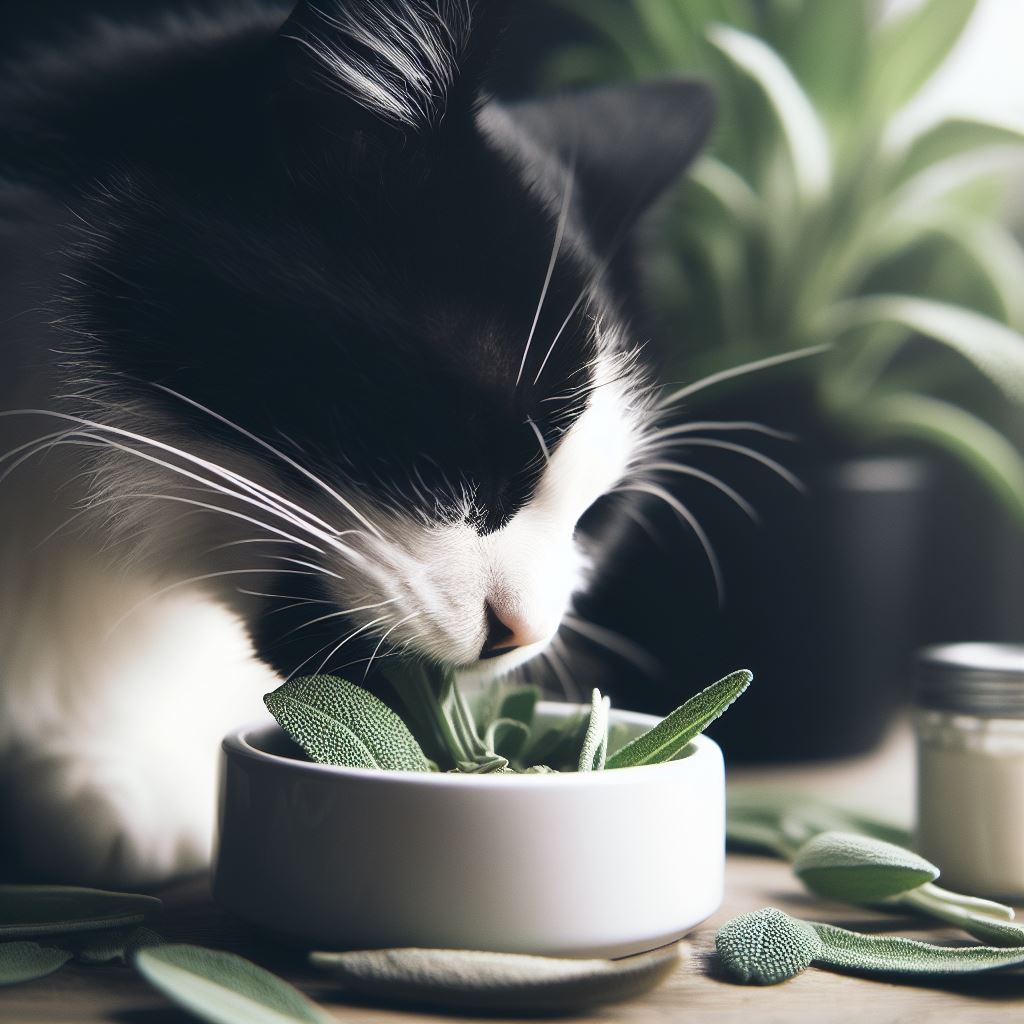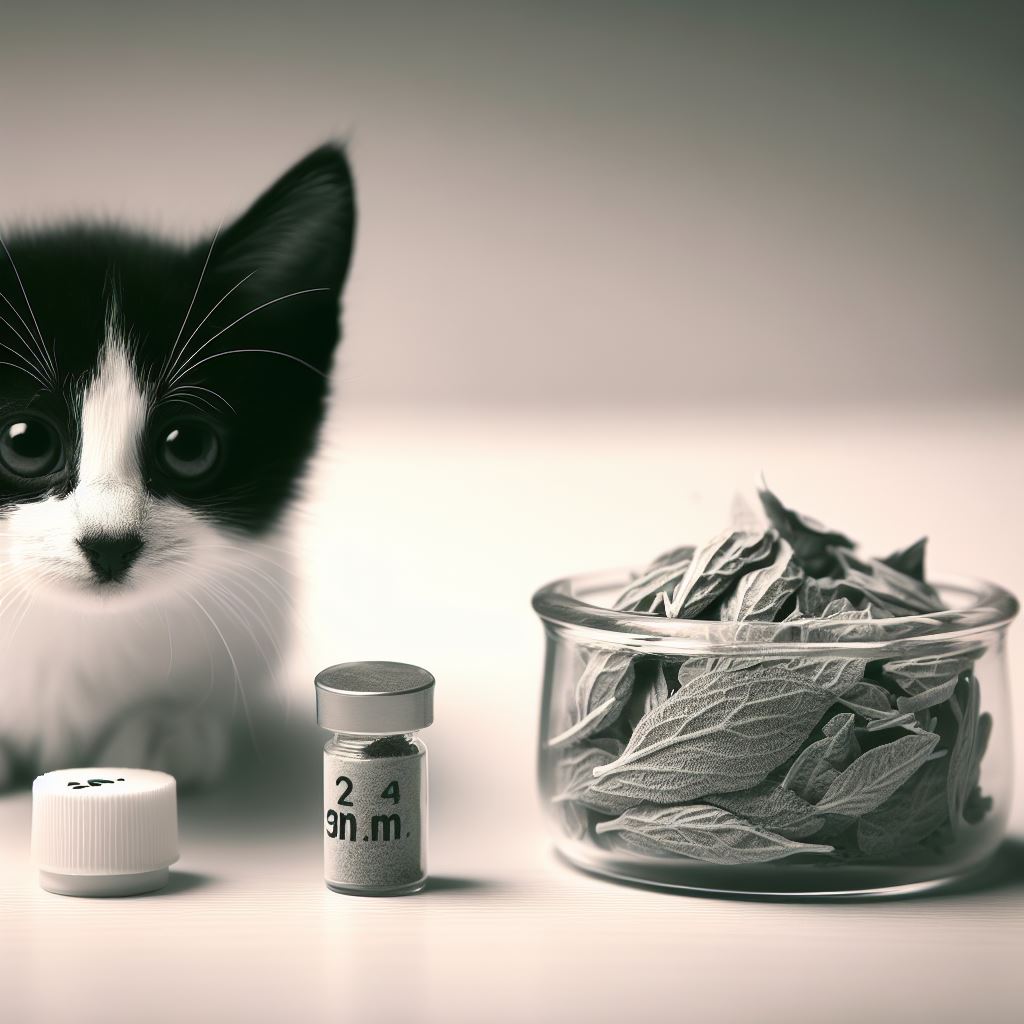Greetings cat lovers! As a fellow cat parent, I know how much our furry friends mean to us. We want to pamper them with affection and tasty treats! But is sage safe for cats to eat?
In this detailed guide, we’ll dive into all things related to feeding sage to cats. We’ll discuss the health benefits, proper dosage, risks and side effects. By the end, your doubts about giving cats sage will be cleared!
When used judiciously, certain herbs can enhance our cats’ diets. But we must educate ourselves on proper usage. Join me to explore the science and safety behind this savory herb. Let us embark on a journey through the world of feline sage consumption!
Sage – An Intriguing Herb for Humans and Felines

The aromatic herb sage has long been popular for its culinary and medicinal uses in humans. But do these same properties apply to cats?
Sage (Salvia officinalis) hails from the mint family. It lends its woodsy, peppery flavor notes to many savory dishes. But sage also contains potent essential oils like thujone and camphor.
These compounds give sage its robust taste and heady scent. However, the oils also make sage risky in high doses. So what does this mean for feeding our whiskered companions?
Let’s first examine how sage might benefit cats when used cautiously. Then we’ll dive into the proper dosage limits and potential side effects. Knowledge is power when exploring new foods or herbs!
Potential Benefits of Sage for Cats
While research is limited, some promising studies suggest sage may offer certain benefits for cats when used sparingly:
Antioxidants for Immunity and Cell Health
Sage contains antioxidant compounds like rosmarinic acid and vitamin E. Antioxidants limit damaging free radicals and inflammation.
This soothing effect may support immune function and overall cell health. More research on sage’s antioxidant effects in live subjects is still needed.
Anti-Inflammatory Properties
The rosmarinic acid in sage also exhibits anti-inflammatory abilities. Reducing inflammation could provide relief for conditions like arthritis and bowel issues.
Again, most studies of sage’s anti-inflammatory effects involve lab tests. But the results are intriguing!
Antimicrobial Powers Against Bacteria and Fungi
Lab research indicates sage repels or destroys certain bacteria, fungi, and other microbes. When consumed, sage may protect cats from organisms that cause issues like food poisoning.
However, we require clinical trials to verify antimicrobial benefits within the feline body. Still, the early results give hope!
Digestive Aid for Upset Stomachs
Sage may relax gastrointestinal muscles and stimulate bile flow. This helps explain why it’s traditionally used for human tummy troubles.
So in small amounts, sage could potentially soothe kitty digestive issues like vomiting, gas, and appetite loss as well. More research is warranted.
Insect-Repelling Properties
Some natural flea and tick sprays for cats contain sage. When cats lick their coated fur, they ingest a bit of sage. This might offer protection from pests!
While the evidence is limited, sage shows promise for our fur babies. Next, let’s explore the right sage dosages for cats.
Recommended Sage Dosage for Cats

Sage contains toxic compounds in high amounts. But small infrequent doses may be safe. Here are general guidelines:
- Dried Sage: 1/8 tsp or less mixed into food 1-2 times per week
- Fresh Sage: 1/4 tsp finely chopped sage 2 times weekly
- Sage Oil: Not recommended due to toxicity concerns
- Overall: Less than 1% of your cat’s total weekly diet
I suggest starting with even smaller amounts and gradually increasing to these limits while monitoring for any intolerance.
It’s crucial we don’t exceed these tiny sage dosages for our cats! Now let’s discuss how to introduce sage safely.
7 Tips for Serving Sage to Cats
Here are some purr-fect tips for incorporating sage into your cat’s menu:
1. Check with your exotic vet first
Consult an exotic pet veterinarian before feeding sage, especially if your cat takes medication. Vets can provide dosage advice specific to your feline.
2. Select high-quality sage
Purchase fresh sage leaves or organic dried sage. Avoid cheap sage flavorings or ground stems. Quality is key!
3. Chop or grind sage finely
Finely mince or grind dried sage to release the aromatic oils and enhance palatability.
4. Mix sparingly into food
Add a tiny pinch of ground sage or 1/4 tsp fresh small sage pieces to your cat’s regular meals.
5. Start with a pinch
Begin with just a sprinkle of sage and slowly increase over time while monitoring for any digestive upset.
6. Avoid giving sage on an empty stomach
Serve sage mixed thoroughly into food. Feeding with meals minimizes absorption of compounds in the gastrointestinal tract.
7. Stop at the first sign of trouble
Immediately halt sage if you notice vomiting, diarrhea, weakness, or other concerning symptoms. When in doubt, stop sage and call your vet.
By following these tips, sage may provide benefits without causing harm. But what signs of intolerance should we watch for?
Signs of Potential Sage Intolerance in Cats
When first trying sage, monitor for these possible adverse reactions:
- Refusing food containing sage
- Excessive drooling or mouth irritation
- Vomiting, regurgitation or diarrhea
- Decreased appetite or lethargy
- Muscle tremors or jerky movements
- Difficulty walking or standing
If you see any of these sage side effects, stop giving it and contact your vet promptly. Some cats may never tolerate sage well. Respect your cat’s needs!
Next, let’s explore which cats should avoid sage completely.
Cats Who Should Avoid Sage
For some cats, even tiny amounts of sage may be unsafe. Sage is not recommended for:
- Kittens under 1 year old
- Elderly cats over 10 years old
- Pregnant or nursing cats
- Cats with liver or kidney disease
- Cats taking certain medications like phenobarbital
For these vulnerable cats, avoid sage. Their bodies struggle to process toxins. When in doubt, consult your feline-friendly vet.
Now let’s examine the possible risks and side effects of improperly dosed sage. Caution is required!
Potential Risks and Side Effects of Sage for Cats

While sage shows promise in small doses, too much can be treacherous. Possible side effects include:
Toxicity from Thujone
The thujone in sage is toxic at high levels. It may cause vomiting, tremors, seizures, and even organ damage or death. Cats are especially sensitive to thujone.
Sage essential oil has the highest thujone content. But dried or fresh sage also contains some.
Gastrointestinal Distress
Excess sage intake can irritate the mouth and digestive tract. Effects may include drooling, nausea, cramps, and diarrhea.
Allergic Reactions
Some cats may be allergic to sage compounds. Reactions can involve skin irritation, swelling, respiratory issues, and other signs.
Medicine Interactions
Thujone may interact with drugs for seizures, anxiety, muscle spasms, and pain. Using sage with these medications is unadvisable.
Clearly, proper dosage is crucial when using sage! Let’s recap some key tips for avoiding toxicity.
Key Reminders for Avoiding Sage Toxicity
To keep your cat safe, remember:
- Stick within recommended serving sizes
- Introduce sage slowly and incrementally
- Watch closely for any intolerance signs
- Don’t give sage essential oil
- Avoid long-term heavy use
- Consult an exotic vet before using sage
- Store sage properly in an airtight container away from light
With mindful moderation and monitoring, short-term light sage use seems unlikely to cause harm. But mistakes can be made when using any herb.
Proper education is paramount when considering new supplements! Let’s continue building our knowledge base.
Healthy Ways to Add Sage to Feline Food
If your cat tolerates sage well, here are some purr-fect ways to incorporate it:
- Sprinkle a pinch of ground sage on top of commercial or homemade cat food
- Add a small pinch of rubbed sage to raw homemade cat food before cooking
- Gently rub a fresh sage leaf between your fingers over food to release oils
- Place a fresh sage leaf in broth, remove after a few minutes of steeping
- Garnish your cat’s food with tiny freshly minced sage pieces
- Add a tiny sage pinch to homemade treat recipes
Remember – sage should complement your cat’s diet rather than dominate it! Use sparingly for occasional variety.
Concluding Thoughts on Cats and Sage
Like many aspects of health, sage involves tradeoffs. At high doses, toxic compounds in sage can endanger cats. But when used judiciously, sage offers some benefits from its antioxidant content and other properties.
By starting slowly with sage and monitoring reactions, most cats tolerate it well as an occasional treat. Talk to your vet before introducing new herbs, and discontinue sage at the first sign of trouble.
If your cat enjoys sage’s flavor, incorporating it modestly into their diet seems unlikely to cause harm. But restraint is imperative, as is carefully controlling quantities.
While more research is needed, sage remains an intriguing subject. With prudence and education, cat parents can make wise decisions. When in doubt, exercise caution!
As with all supplements, recognize that individual animals have unique needs and tolerances. Not all cats are alike! Work closely with your vet and respect your cat’s preferences.




